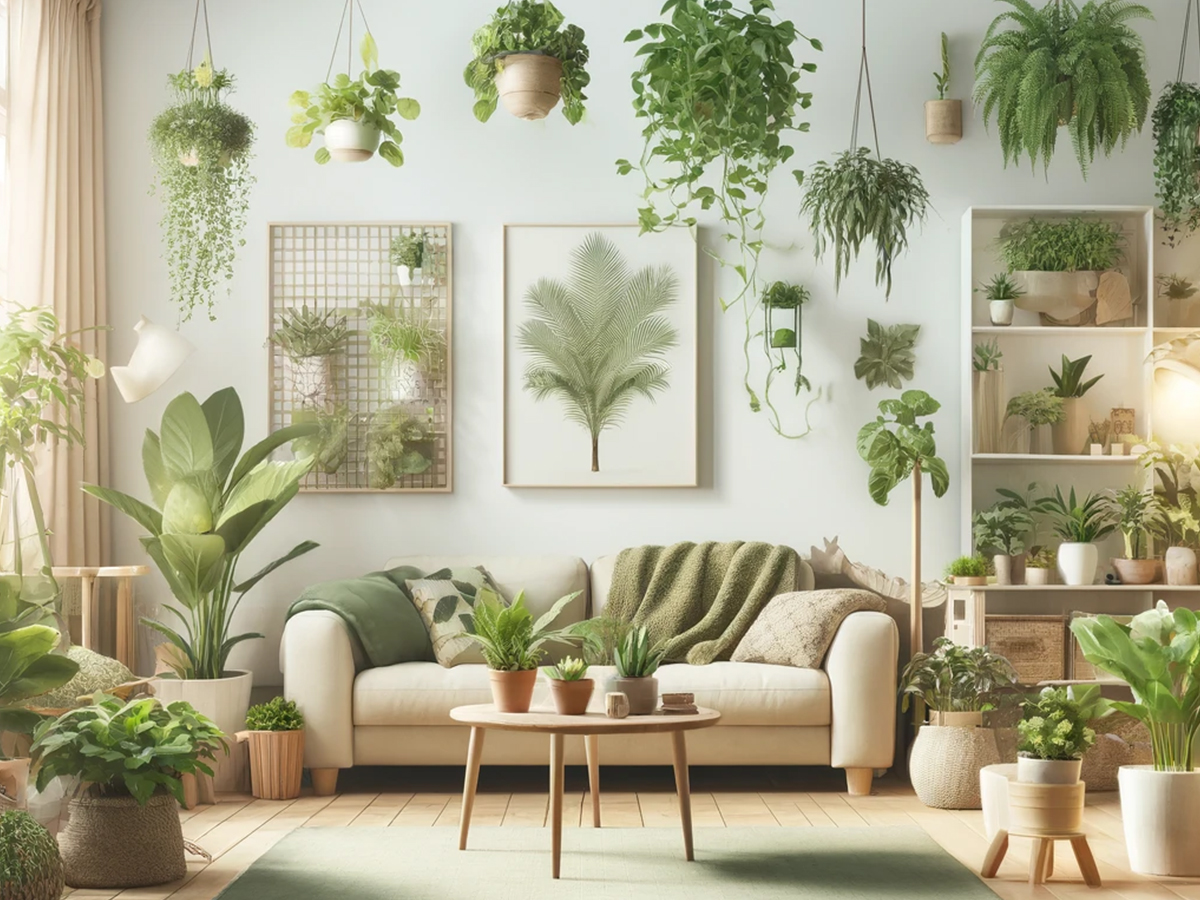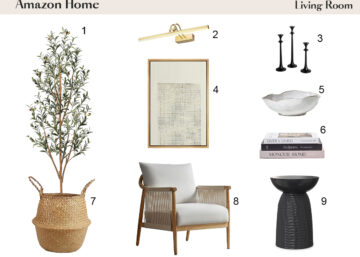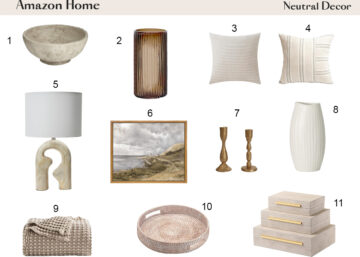Decorating with Plants: Bringing Life to Your Interiors
Introduction: Embracing Nature Within
In the bustling world of interior design, one element often overlooked yet profoundly impactful is the presence of nature. Beyond mere aesthetics, integrating plants into interior spaces introduces a dynamic interplay between the built environment and the natural world. This introduction seeks to shed light on the transformative power of plants in interior design, exploring their multifaceted role in enhancing well-being, improving air quality, and infusing spaces with vitality and warmth. As we delve into the realm of decorating with plants, we embark on a journey of discovery, uncovering the symbiotic relationship between humans and the greenery that surrounds us.
The Power of Greenery: Enhancing Interior Spaces
Greenery Beyond Aesthetics
In the realm of interior design, the significance of greenery extends far beyond its visual appeal. While plants undoubtedly add a touch of natural beauty to indoor environments, their influence goes much deeper, touching on aspects of human health, well-being, and connectivity with nature.
Biophilic Benefits
Biophilic design principles emphasize the innate human connection to nature and advocate for incorporating natural elements into built environments. Plants play a central role in biophilic design, offering myriad benefits that resonate with our evolutionary history as beings deeply rooted in the natural world. By integrating greenery into interior spaces, designers can evoke feelings of tranquility, restoration, and connection with the outdoors.
Improving Air Quality
One of the most well-documented benefits of indoor plants is their ability to improve air quality by filtering out harmful pollutants and releasing oxygen through photosynthesis. Studies have shown that certain species of plants can effectively remove volatile organic compounds (VOCs) such as formaldehyde, benzene, and xylene from the air, thereby creating healthier indoor environments for occupants.
Enhancing Well-being
In addition to their air-purifying qualities, plants have been linked to various psychological and physiological benefits that contribute to overall well-being. Research suggests that exposure to indoor greenery can reduce stress, anxiety, and symptoms of depression, while promoting feelings of calmness, happiness, and productivity. The presence of plants in interior spaces has also been associated with improved cognitive function, concentration, and creativity, making them valuable assets in both residential and commercial settings.
Creating Ambiance and Comfort
Beyond their health-promoting properties, plants have a remarkable ability to enhance the ambiance and comfort of interior spaces. From softening harsh architectural lines to adding warmth and texture, greenery can imbue rooms with a sense of coziness, vitality, and personality. Whether used as focal points, decorative accents, or living room dividers, plants have the power to transform ordinary spaces into inviting sanctuaries that nurture the body, mind, and soul.
Choosing the Right Plants: Tailoring Greenery to Interior Spaces
Factors to Consider
Selecting the appropriate plants for interior spaces requires careful consideration of various factors, including light levels, space constraints, maintenance requirements, and aesthetic preferences. By understanding the unique needs and characteristics of different plant species, designers can curate indoor gardens that thrive in their intended environments, adding beauty and vitality to interior settings.
Light Requirements
One of the most critical factors to consider when choosing indoor plants is their light requirements. While some plants thrive in bright, indirect sunlight, others prefer low-light conditions. Assessing the available natural light in a space is essential for determining which plants are best suited to the environment. South-facing windows typically receive the most sunlight throughout the day, while north-facing windows tend to offer lower light levels. By matching plants to their ideal light conditions, designers can ensure their long-term health and vitality.
Space Considerations
In addition to light requirements, space constraints also play a crucial role in plant selection. Not all indoor environments have ample space for large potted plants or sprawling foliage. For smaller spaces, designers may opt for compact or trailing varieties that can thrive in limited square footage. Hanging plants, vertical gardens, and wall-mounted planters are excellent space-saving solutions that allow greenery to flourish without encroaching on valuable floor space.
Maintenance Needs
Another factor to consider when choosing indoor plants is their maintenance requirements. While some plants are relatively low-maintenance and forgiving of occasional neglect, others may require more frequent watering, pruning, or fertilizing. Designers should assess the time and effort clients are willing to dedicate to plant care and select species accordingly. Additionally, considering the client’s lifestyle, travel schedule, and level of gardening experience can help determine the most suitable plants for their needs.
Popular Indoor Plant Varieties
There is a wide variety of indoor plants available, each with its unique characteristics and care requirements. Some popular options for interior spaces include:
- Snake Plant (Sansevieria): Known for its air-purifying properties and resilience to neglect, the snake plant thrives in low-light conditions and requires minimal watering.
- Pothos (Epipremnum aureum): A versatile and easy-to-care-for plant, pothos is prized for its trailing vines and tolerance to low-light environments.
- Fiddle Leaf Fig (Ficus lyrata): With its large, glossy leaves and sculptural form, the fiddle leaf fig adds a touch of elegance to interior spaces but requires bright, indirect sunlight to thrive.
- Spider Plant (Chlorophytum comosum): Ideal for beginners, spider plants are known for their air-purifying abilities and easy propagation.
- ZZ Plant (Zamioculcas zamiifolia): Resilient and drought-tolerant, ZZ plants are well-suited to low-light conditions and require minimal maintenance.
Customizing Plant Selection
Ultimately, the selection of indoor plants should be tailored to the specific needs, preferences, and constraints of each interior space. By considering factors such as light levels, space availability, maintenance requirements, and aesthetic preferences, designers can curate personalized greenery collections that enhance the beauty and functionality of interior environments. Whether creating a lush jungle retreat or a minimalist oasis, the right selection of indoor plants can breathe life into any space, transforming it into a vibrant and inviting sanctuary.
Incorporating Plants into Interior Design: A Seamless Integration
Strategic Placement
Once the selection of indoor plants is finalized, the next step is to strategically incorporate them into interior design schemes. Placement plays a crucial role in maximizing the visual impact of greenery while ensuring harmony with the surrounding decor. Designers should consider focal points, traffic flow, and balance when determining the placement of plants within a space.
Focal Points and Accents
Plants can serve as effective focal points or accents within interior settings, drawing the eye and adding visual interest. Large, statement plants placed in prominent areas such as entryways, living rooms, or dining areas can command attention and serve as conversation starters. Smaller plants strategically positioned on shelves, mantels, or side tables can add touches of greenery throughout the space, creating cohesive design narratives.
Grouping Techniques
Grouping plants together can create dynamic compositions that elevate the overall aesthetic of interior spaces. Clustering plants of varying heights, shapes, and textures can add depth and dimension to tabletops, countertops, or plant stands. Designers may also experiment with creating botanical vignettes by combining plants with decorative accessories such as pots, vases, or sculptures, further enhancing visual interest.
Vertical Gardens and Living Walls
Vertical gardens and living walls offer innovative solutions for incorporating greenery into interior spaces, particularly in areas with limited floor space. By installing modular planters or wall-mounted systems, designers can create lush, verdant backdrops that blur the boundaries between indoors and outdoors. Vertical gardens can be customized to fit a range of aesthetic preferences, from sleek and modern to rustic and organic, making them versatile additions to residential and commercial interiors alike.
Biophilic Design Principles
Incorporating plants into interior design aligns with the principles of biophilic design, which seeks to foster a deeper connection between humans and nature within built environments. By integrating natural elements such as plants, wood, and water, designers can create environments that promote well-being, productivity, and creativity. Biophilic design principles emphasize the importance of incorporating elements of nature into interior spaces to enhance occupants’ physical and psychological health.
Creating Tranquil Retreats
In today’s fast-paced world, interior spaces that evoke feelings of tranquility and relaxation are highly sought after. Plants can play a key role in creating serene retreats within homes, offices, or commercial establishments. By strategically placing plants in areas where people gather, work, or unwind, designers can cultivate environments that foster a sense of calmness, rejuvenation, and connection with the natural world.
Bringing the Outdoors In: Embracing Nature’s Influence
Harnessing Nature’s Benefits
Bringing the outdoors into interior spaces extends beyond the mere placement of plants—it involves creating environments that embrace nature’s influence in its entirety. From natural materials to organic textures, designers can draw inspiration from the outdoor world to craft interior settings that evoke a sense of harmony, balance, and connection with the natural environment.
Incorporating Natural Materials
One way to bring the outdoors in is by incorporating natural materials into interior design schemes. From wood and stone to bamboo and rattan, natural materials add warmth, texture, and authenticity to interior spaces. By selecting sustainably sourced materials, designers can create environments that not only mimic the beauty of nature but also promote environmental stewardship and responsible design practices.
Biophilic Elements Beyond Plants
While plants are a central component of biophilic design, there are numerous other elements that can be incorporated to enhance the connection between indoor spaces and the natural world. Water features such as indoor fountains or tabletop water gardens can introduce soothing sounds and visual interest, evoking the tranquility of natural landscapes. Natural light, fresh air, and views of outdoor scenery are also essential biophilic elements that can be optimized through thoughtful architectural design and spatial planning.
Blurring the Boundaries
Blurring the boundaries between indoor and outdoor spaces is another effective strategy for bringing the outdoors in. Floor-to-ceiling windows, sliding glass doors, and indoor-outdoor living areas create seamless transitions between interior and exterior environments, allowing occupants to feel immersed in nature’s beauty while enjoying the comforts of indoor living. Incorporating outdoor elements such as patios, terraces, and gardens into interior design schemes enhances the overall sense of openness, freedom, and connection with the surrounding landscape.
Embracing Seasonal Changes
Designing interior spaces that embrace seasonal changes allows occupants to experience the beauty of nature year-round. By selecting plants and materials that reflect the colors, textures, and patterns of each season, designers can create dynamic and ever-evolving environments that celebrate the passage of time. From vibrant blooms and lush foliage in spring and summer to rich earth tones and cozy textiles in fall and winter, seasonal design elements add depth, interest, and vitality to interior spaces.
Wellness and Sustainability
In addition to aesthetic considerations, bringing the outdoors in has tangible benefits for occupant well-being and environmental sustainability. Exposure to natural elements such as sunlight, fresh air, and greenery has been shown to reduce stress, improve mood, and enhance cognitive function. By prioritizing sustainable design practices and incorporating biophilic elements into interior spaces, designers can create environments that promote health, happiness, and ecological balance.
Plants for Specific Interior Settings: Tailoring Greenery to Enhance Spaces
Living Room
The living room is often the focal point of a home, where family and guests gather to relax and socialize. When selecting plants for the living room, it’s essential to choose varieties that complement the existing decor and furniture while adding visual interest and personality to the space. Large, statement plants such as fiddle leaf figs or palms can anchor seating areas and fill empty corners, while smaller plants like succulents or pothos can be placed on coffee tables or shelves to add touches of greenery without overwhelming the space.
Dining Area
In the dining area, plants can create a welcoming atmosphere and enhance the dining experience for occupants. Consider placing a small herb garden on the windowsill or a centerpiece of fresh flowers on the dining table to add a natural touch to mealtime. Hanging plants such as trailing ivy or spider plants can also be suspended above the dining area to create visual interest and draw the eye upward, making the space feel more expansive.
Bedroom
In the bedroom, plants can promote relaxation and improve air quality, creating a peaceful sanctuary for rest and rejuvenation. Opt for low-maintenance varieties such as snake plants or peace lilies that thrive in low-light conditions and help purify the air. Place plants on bedside tables, dressers, or window sills to bring nature indoors and create a tranquil ambiance conducive to sleep and relaxation.
Home Office
In the home office, plants can boost productivity, creativity, and overall well-being. Select plants with air-purifying properties such as ZZ plants or rubber trees to improve indoor air quality and create a healthier work environment. Place plants on desks, bookshelves, or windowsills to bring a touch of nature into the workspace and counteract the effects of artificial lighting and electronic devices.
Bathroom
In the bathroom, plants can thrive in the warm, humid conditions typically found in this space. Consider incorporating moisture-loving plants such as ferns, orchids, or bamboo to add a spa-like ambiance and enhance the visual appeal of the bathroom. Place plants on countertops, shelves, or windowsills, ensuring they receive adequate light and ventilation to thrive in this unique interior setting.
Conclusion: Embracing the Green Revolution in Interior Design
Enhancing Spaces with Nature
In today’s fast-paced world, the incorporation of plants into interior design has become more than just a trend—it’s a movement towards creating healthier, more sustainable, and visually captivating living environments. By embracing the power of greenery, designers can transform ordinary spaces into thriving sanctuaries that nourish the body, mind, and soul. From living rooms to bedrooms, home offices to bathrooms, the integration of plants enhances the overall ambiance of interior settings, promoting well-being, productivity, and connection with the natural world.
Tailoring Greenery to Specific Settings
Understanding the unique characteristics of different interior settings allows designers to tailor greenery to maximize its impact. Whether selecting plants for the living room, dining area, bedroom, home office, or bathroom, considerations such as lighting, humidity, and available space play a crucial role in determining which varieties will thrive. By carefully curating plant selections and placement, designers can create personalized environments that reflect the preferences and lifestyles of occupants, fostering a deeper connection with nature within the comforts of home.
Promoting Wellness and Sustainability
Beyond their aesthetic appeal, plants offer tangible benefits for occupant well-being and environmental sustainability. Studies have shown that exposure to indoor plants can reduce stress, improve mood, and enhance cognitive function, making them essential elements in promoting overall wellness. Additionally, incorporating plants into interior settings supports ecological balance by purifying indoor air, conserving energy, and promoting biodiversity. By prioritizing sustainable design practices and biophilic principles, designers can create interior spaces that not only look beautiful but also contribute to a healthier planet for future generations.
Continuing the Green Revolution
As the demand for greener, more sustainable living environments continues to grow, the integration of plants into interior design will remain a central focus for designers, homeowners, and businesses alike. By embracing the green revolution and incorporating nature-inspired elements into interior settings, we can create spaces that inspire, rejuvenate, and uplift the human spirit. Together, let us continue to harness the power of greenery to transform our interiors into vibrant, thriving habitats that support our well-being and connect us to the beauty of the natural world.








